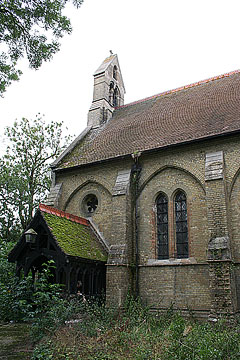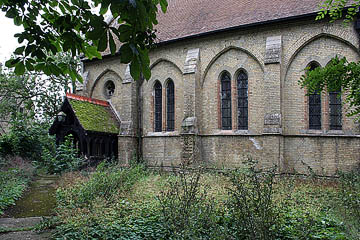The buildings of Guyhirn sit huddled along a small road, overlooked by the banks of the mighty Nene and always within earshot of the A47 which takes traffic thundering from King’s Lynn to Peterborough. Like many fenland settlements, it is faintly surprisingly that it exists at all.
Still, unlike many fenland settlements, Guyhirn is not a Victorian invention. Just down the road from St Mary Magdalene is a lovely 17th century chapel, and it is believed that on the site of the present church there was either a parish church or a chantry. Either way, it had disappeared by the 16 th century, and Guyhirn was part of the vast parish of Whittlesey.
To cater for a larger population (and better to stem the tide of nonconformism that swept through the fens in the 19th century), a new parish church was built here in 1878. The architect was George Gilbert Scott: a mighty name for such a small place.
He erected a big yellow brick hall of an interesting design: there is no tower, but there is a nice little bell-turret, and the side walls are decorated with big blind arcades into which are set double lancet windows. Here, one can imagine the Bishop of Ely thinking, in the place where man conquers the fens the church triumphant will conquer dissent, and the people of Guyhirn will return to the flock. Sic transit superbia Victoriae Aetatis.
I can’t find out when this church was made redundant (it can’t be more than twenty years, I think, since the information boards in the chapel talk of it as though it were still active) but it is definitely dying now.
The churchyard is grim and overgrown, and the lovely little black timber porch is filled with cobwebs and cans of Carling. Ivy is starting to gnaw at the buttresses, in a race with the rising waters to see which agent of implacable nature will destroy this transient monument first.
St Mary Magdalene is very definitely closed.

